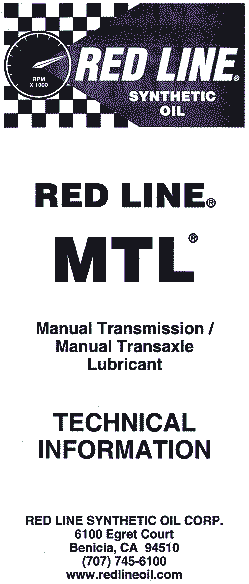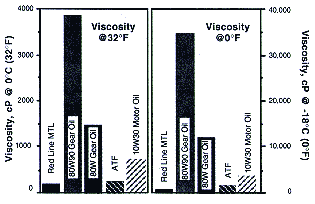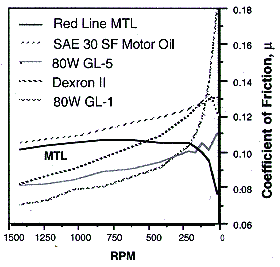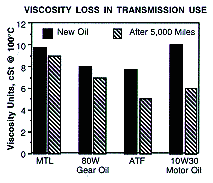Red Line MTL & MT-90 Technical Information
Presented by Jeff Lucius
The information and figures below are directly from Red Line's printed material and all rights are reserved by them. I present this information solely for educational purposes.
 RED LINE MTL® and MT-90 are designed to provide excellent protection and improved shiftability for manual transmissions and transaxles. MTL and MT-90 have cured the problem of hard shifting in numerous transmissions which have notoriously difficult shifting. The secret to their success is two-fold. First, they have the appropriate coefficient of friction for most manual transmission synchronizers. Many gear oils, engine oils, and ATFs are too slippery for proper synchro engagement. Secondly, the viscosity characteristics of MTL and MT-90 allow proper shifting over the entire temperature range which the transmission will experience. The synthetic base oils used have a very high viscosity index which provides relatively constant viscosity as temperature changes. MTL is a low 75W, almost a 70W, at very low temperatures and a high 80W, nearly an 85W, at elevated temperatures, providing adequate viscosity to prevent wear and deaden gear noise. MT-90 is a thicker 75W90 version of MTL. The shear stability and oxidation stability of these products are excellent, thus the physical characteristics of Red Line MTL and MT-90 will change little with use.
RED LINE MTL® and MT-90 are designed to provide excellent protection and improved shiftability for manual transmissions and transaxles. MTL and MT-90 have cured the problem of hard shifting in numerous transmissions which have notoriously difficult shifting. The secret to their success is two-fold. First, they have the appropriate coefficient of friction for most manual transmission synchronizers. Many gear oils, engine oils, and ATFs are too slippery for proper synchro engagement. Secondly, the viscosity characteristics of MTL and MT-90 allow proper shifting over the entire temperature range which the transmission will experience. The synthetic base oils used have a very high viscosity index which provides relatively constant viscosity as temperature changes. MTL is a low 75W, almost a 70W, at very low temperatures and a high 80W, nearly an 85W, at elevated temperatures, providing adequate viscosity to prevent wear and deaden gear noise. MT-90 is a thicker 75W90 version of MTL. The shear stability and oxidation stability of these products are excellent, thus the physical characteristics of Red Line MTL and MT-90 will change little with use.
Red Line MTL is classified as a 75W/80W gear lubricant satisfying the API Service requirements of GL-3 and GL-4. MTL also satisfies motor oil viscosities SAE 5W/10W/30, and the viscosity requirements for ATFs. MT-90 is a 75W90 GL-4 and also satisfies motor oil viscosities SAE 10W/1 5W/40. The additive chemistry used is non-corrosive, so even though they will provide GL-4 performance, they will not corrode synchros or bushings. Because of its low corrosivity, Red Line MTL and MT-90 could also be used in transmissions requiring GL-1 or GL-3 lubricants. Seal compatibility is designed to be similar to petroleum-based lubricants.
BENEFIT SUMMARY
- Eliminates notchy shifting
- Designed for manual transmissions and transaxles
- Perfect synchronizer coefficient of friction
- Enables high-speed downshifting
- Excellent shifting even when cold
- Eliminates gear whine and rattle at high temperatures
- High-performance gear protection
- Non-corrosive toward synchronizers
- Satisfies manual transmissions and transaxles requiring motor oils, or GL-1, GL-3, or GL-4 gear oils
IMPROVES SHIFTING
Red Line MTL and MT-90 are able to improve shifting in most manual transmissions and transaxles. They provide a relatively constant viscosity as temperature changes and provides the proper coefficient of friction to allow synchronizer engagement. Most gear oils are very viscous at lower temperatures. This higher viscosity requires increased shift effort to move the synchronizer gears with the shift fork and to squeeze the oil from between the synchronizer cone and the mating surface attached to the gear. Without contact of these two surfaces, the gear speeds will not be synchronized and locking of the synchromesh gears will not occur. Excessive viscosity results in a longer time required to synchronize before locking occurs.
Viscosity of common lubricants at OºC (32ºF) is compared with Red Line MTL in the chart below. Note that the viscosity of ATF and 10W30 motor oil seems to be adequate. These lubricants are not well suited for transmission use because of two factors - shear stability and improper coefficient of friction - which will be discussed in more detail later. At even lower temperatures such as -17.7ºC (OºF), the differences between conventional lubricants and Red Line MTL are even more dramatic. At such a temperature many of these lubricants would prevent shifting into certain gears, depending on the design of the transmission.
 All oils are slippery, and with most lubricated components, the slipperier the better, but this is not so with manual transmissions. The synchronization of shifting gears requires friction to transfer energy from the synchronizer, which is locked to the input shaft, to its mating surface attached to the gear to be locked in as the drive gear. Few modern transmissions use sliding gears to change gearing other than for reverse gearing. Synchromesh transmissions have the gear pairs constantly in mesh. The drive gear is selected by using the shift forks to slide a synchronizer ring, which rotates at the same speed as the input shaft, in contact with the selected drive gear. Once the drive gear is brought to the same speed as the input shaft, the locking ring on the synchro assembly is allowed to slide over and lock into the drive gear.
All oils are slippery, and with most lubricated components, the slipperier the better, but this is not so with manual transmissions. The synchronization of shifting gears requires friction to transfer energy from the synchronizer, which is locked to the input shaft, to its mating surface attached to the gear to be locked in as the drive gear. Few modern transmissions use sliding gears to change gearing other than for reverse gearing. Synchromesh transmissions have the gear pairs constantly in mesh. The drive gear is selected by using the shift forks to slide a synchronizer ring, which rotates at the same speed as the input shaft, in contact with the selected drive gear. Once the drive gear is brought to the same speed as the input shaft, the locking ring on the synchro assembly is allowed to slide over and lock into the drive gear.
The time this process takes depends on how easily the synchro ring moves and the rate of frictional energy transfer between the two synchronizer surfaces. Higher viscosity lubricants slow the sliding of the synchro ring on the input shaft and require a longer time for the oil to be squeezed out from between the mating synchronizer surfaces. After the lubricant is squeezed out, the coefficient of friction of the lubricant determines the rate of frictional energy transfer between the two surfaces. Slippery lubricants such as hypoid gear oils can take too long to synchronize the gears, which promotes synchronizer wear. Red Line MTL and MT-90 has a coefficient of friction which is greater than conventional oils, allowing a quicker transfer of frictional energy. The graph below shows the desirable friction curve demonstrated by Red Line MTL compared to conventional lubricants. Note how the coefficient of friction is greater for the MTL than all others except the motor oil. Some motor oils have an adequate dynamic coefficient of friction, but most have problems with the static and low velocity coefficient of friction which can result in clashing.
Clashing of the gears (actually clashing of the synchromesh gears, since the drive gears are always in contact) can occur if excessive shift effort is used in order to shift the locking ring into place before the surfaces have achieved equal speed. It may also occur at the end of a reasonably smooth shift if an instability exists in the coefficient of friction, causing stick-slip to occur. In this form of clashing, the ring slides on the mating synchro gear, but a sudden slippage causes a grinding of the gears. In order to prevent stick-slip from occurring and the gear clashing which results, the coefficient of friction should inflect downward as the relative speed drops to zero.

GEAR AND SYNCHRONIZER WEAR PROTECTION
Most manufacturers of manual transmissions and transaxles recommend an 80W or 90W GL-4 lubricant. GL-5 gears oils which are required in hypoid differentials are not used in most synchromesh transmissions because the chemicals used to provide the extreme pressure protection can be corrosive to synchronizers, which are commonly made of brass or bronze. Typically, the use of a GL-5 lubricant in a synchromesh transmission will shorten the synchronizer life by one half. The extreme pressure, requirements of spur gears and helical gears found in transmissions are not nearly as great as found in rear-wheel drive differentials. A GL-4 lubricant provides adequate protection for most manual transmissions, unless a unique design consideration requires the extra protection of a GL-5.
The reason that many manufacturers have made recommendations of motor oils or ATFs is that petroleum 80W gear oils frequently do not shift well at low temperatures. Motor oils and ATFs are much more fluid at lower temperatures and they are not corrosive toward synchros, but they provide very poor gear protection. These lubricants provide almost no extreme-pressure protection. In addition, petroleum multigrade motor oils and ATFs have very poor shear stability. The shearing action by a manual transmission on thickeners is much worse than in an engine or automatic transmission. Within 5,000 miles the thickeners can be rendered ineffective and the transmission will be operating on a much reduced level of protection, as shown in the graph below. In hot weather these transmissions will whine and rattle because of poor vibration dampening and metal contact. Red Line MTL and MT-90 provide the excellent gear protection of a GL-4 gear oil in a synthetic lubricant which spans hot and cold temperatures and will not shear or oxidize with use.

DIRECTIONS FOR USE
Red Line MTL may be used in transmissions which recommend 75W, 80W, or 85W GL-4 gear oils, or SAE 30 or 5W/10W30 motor oils. If a 90W GL-4 or SAE 40, 10W40, or 15W40 is required, MT-90 may be used. If the transmission or transaxle requires an SAE 90 GL-5 gear oil, then Red Line 75W90NS or 75W140NS Gear Oil may be used. In transmissions which recommend Dexron or Mercon fluids we recommend our D4 ATF which is very similar to the MTL, being a GL-4 Gear Oil also. The D4 ATF will provide better low-temperature shiftability, and the MTL would provide better wear protection for racing use. MTL is not designed for use in rear-wheel drive differentials. Those generally require a GL-5 lubricant such as Red Line 75W90 Gear Oil. It is not necessary to flush the transmission before replacing with MTL. Remove the drain plug and drain while warm. Seal compatibility has been designed to be similar to petroleum lubricants, and leakage should be no greater than any other oil of comparable viscosity. Being formulated with extremely stable synthetic basestocks, MTL and MT-90 will last much longer than conventional petroleum lubricants. However, we do not recommend extended drain intervals, since without a filtration system, there is no way to remove metal shavings other than draining the lubricant. The regular maintenance intervals are also recommended to insure that the proper level of the fluid is maintained.
Page last updated March 17, 2002.

 RED LINE MTL® and MT-90 are designed to provide excellent protection and improved shiftability for manual transmissions and transaxles. MTL and MT-90 have cured the problem of hard shifting in numerous transmissions which have notoriously difficult shifting. The secret to their success is two-fold. First, they have the appropriate coefficient of friction for most manual transmission synchronizers. Many gear oils, engine oils, and ATFs are too slippery for proper synchro engagement. Secondly, the viscosity characteristics of MTL and MT-90 allow proper shifting over the entire temperature range which the transmission will experience. The synthetic base oils used have a very high viscosity index which provides relatively constant viscosity as temperature changes. MTL is a low 75W, almost a 70W, at very low temperatures and a high 80W, nearly an 85W, at elevated temperatures, providing adequate viscosity to prevent wear and deaden gear noise. MT-90 is a thicker 75W90 version of MTL. The shear stability and oxidation stability of these products are excellent, thus the physical characteristics of Red Line MTL and MT-90 will change little with use.
RED LINE MTL® and MT-90 are designed to provide excellent protection and improved shiftability for manual transmissions and transaxles. MTL and MT-90 have cured the problem of hard shifting in numerous transmissions which have notoriously difficult shifting. The secret to their success is two-fold. First, they have the appropriate coefficient of friction for most manual transmission synchronizers. Many gear oils, engine oils, and ATFs are too slippery for proper synchro engagement. Secondly, the viscosity characteristics of MTL and MT-90 allow proper shifting over the entire temperature range which the transmission will experience. The synthetic base oils used have a very high viscosity index which provides relatively constant viscosity as temperature changes. MTL is a low 75W, almost a 70W, at very low temperatures and a high 80W, nearly an 85W, at elevated temperatures, providing adequate viscosity to prevent wear and deaden gear noise. MT-90 is a thicker 75W90 version of MTL. The shear stability and oxidation stability of these products are excellent, thus the physical characteristics of Red Line MTL and MT-90 will change little with use.


